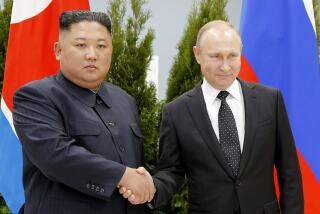U.S.-Soviet Trade Expectations Fade
What a difference a year makes, particularly in U.S.-Soviet relations. A year ago many thoughtful Soviet intellectuals were actually worried that the arms race might lead to war. Now, after two formal summit-level meetings in Geneva, both sides are speaking of cooperative agreements. Even arms control no longer looks like an impossibility.
But we should not exaggerate. Unlike the 1970s, what we have so far is more like a dent--not detente--and expectations are more subdued if not more realistic. In part this is a natural reaction to the over-optimism of the 1970s.
A good example of this more subdued stance is the way U.S.-Soviet trade is being treated this time around. At the 1972 Nixon-Brezhnev summit, trade was a major agenda item, and predictions of agreements and billion-dollar contracts flowed readily from both Moscow and Washington; this time trade seems to be more an afterthought from the Reagan-Gorbachev meeting. As with human rights, the casual reader has to search for mentions of trade in the reports from Geneva. Unlike fusion research or chemical weapons, trade is not even given its own paragraph in the formal communique. In fact, the only mention of trade is in a five-paragraph section headed “Process of Dialogue,” and then it is included almost as a postscript.
While this de-emphasis is probably the conscious effort of Reagan Administration opponents to Soviet trade, there are signs that U.S. businessmen and Soviet leaders have lowered their expectations. After all, American companies will not soon forget the millions of dollars that several of them spent on plans and contract bidding and projects in the Soviet Union that were aborted after the invasion of Afghanistan. The resulting scars explain as much as anything does why last month’s U.S.- Soviet trade and economic council meetings in Moscow attracted fewer senior chief executive officers than similar but more ebullient meetings did in the 1970s.
In his comments, Mikhail S. Gorbachev seemed as subdued as the American businessmen. While he spoke encouragingly of U.S.-Soviet trade, going so far as to arrange for his speech to be televised to the Soviet public, he also underplayed the volume of that trade. By stressing U.S. imports of the Soviet Union’s goods, where we rank 13th among its hard-currency trading partners, rather than U.S. exports to the Soviet Union, where we are first or second, he may have been trying to suggest how much room there was to expand. Yet when he pointed to specific products that the Soviet Union might buy from the United States, he generally confined his list to machines for industry such as agri-business, petrochemicals, chemicals, energy and the machine-tool industry itself. For the most part these would be low-technology exports, many of which even the Pentagon might tolerate.
On the Soviet side, this new realism partly reflects Gorbachev’s leadership style, which is less bombastic and more attuned to the limitations of the Soviet economic system. Soviet authorities have come to recognize that imported technology has not been, and probably will not be, the solution to all their problems--at least as long as there is no reform of their economic system. At a minimum, Gorbachev has come to realize that he needs some new faces. That explains the widely reported purges in Soviet industrial ministries. Now it is rumored that as many as 200 officials in Soviet foreign-trade offices have been arrested on charges of corruption, and at least two--the chairman and the deputy of Technopromexport--have been sentenced to death.
But, for all his domestic efforts, Gorbachev seems to realize that before there can be any meaningful improvement in U.S. trade the Soviet Union must improve its treatment of dissidents and refusedniks. Only then will the United States move to relax some of the restraints that it imposes on imports from and exports to the Soviets.
Admittedly the initial efforts to reach accommodation predate Gorbachev, but he has continued the effort even if at a cautious pace. That accounts for the release of Yelena Bonner and about a dozen spouses of U.S. citizens and some long-term Jewish refusedniks. It also explains the various continuing meetings between Soviet officials and Jewish leaders in New York, Moscow and Paris, as well as the hints about the even larger-scale emigration in 1986 and the possible restoration of diplomatic recognition between the Soviet Union and Israel. It also accounts for the decision to allow each leader to address the other’s country via television, and the somewhat more conciliatory tone coming out of at least some Washington offices.
It may be that we do occasionally learn from history. Unlike the euphoric 1970s, when visions of hundreds of millions of dollars in trade deals danced in our heads and trade was viewed as a means or linkage to improve political relations, today trade seems to be the end or reward for improved political relations. Given how controversial U.S. trade with the Soviet Union can be, this seems to be the more realistic and ultimately more fruitful way.
More to Read
Sign up for Essential California
The most important California stories and recommendations in your inbox every morning.
You may occasionally receive promotional content from the Los Angeles Times.










